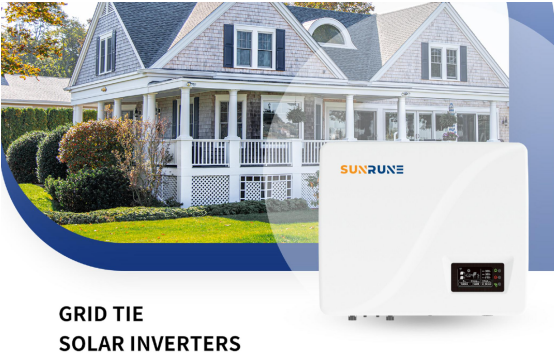What’s the grid-tied Solar System?
A grid-tied solar inverter system, also known as “grid-tied” or “grid-connected”, is a device that uses solar panels to generate alternating current (AC) electricity and feed it into the grid. In other words, it’s a solar system that uses the grid as an energy reserve (in the form of bill credits).
Grid-connected systems typically do not use batteries, but instead rely on the grid for power when the solar panels are not generating enough electricity (e.g. at night). In this case, the inverter will automatically disconnect from the grid. A typical grid-connected solar system consists of the following main components
Solar panels; grid-tied solar inverter; electricity meter; wiring. Auxiliary components such as AC switches and distribution boxes
Solar panels collect sunlight and convert it into DC electricity. A grid-tied inverter converts the DC power into AC power, which is then transmitted to the grid through wires.
The utility company provides net metering to track the amount of electricity produced by the system. Based on the readings, the utility company credits your account for the amount of electricity you generate.
How does a grid-tie inverter work?
A grid-tie solar inverter works like a conventional solar inverter, with one significant difference: a grid-tie inverter converts the DC power output from the solar panels directly into AC power. It then synchronises the AC power to the grid frequency.
This is in contrast to traditional off-grid inverters, which convert DC to AC and then regulate the voltage to meet the system’s requirements, even if those requirements differ from the utility grid. Here’s how a grid-tied inverter works.

During peak hours of sunlight, solar panels may produce more electricity than the household needs. In this case, the excess electricity is fed into the grid and you receive a credit from the utility company.
At night or during cloudy weather, if the solar panels do not produce enough electricity to meet your household’s needs, you will draw electricity from the grid as normal.
Grid-connected solar inverters must be able to shut down automatically if the utility grid goes down, as it can be dangerous to supply power to a grid that is down.
Grid-tied inverters with batteries
Some grid-tied solar inverters come with battery backup, which means they can store the electricity generated by the solar panels. This is particularly useful when the grid is down but the solar panels are still generating electricity.
Grid-tied inverters with battery storage are known as hybrid inverters. The batteries help to smooth out fluctuations in the output of the solar panels, providing more stable power for your home or business.
Conclusion
Grid-connected solar inverters are becoming increasingly popular as more people look for ways to reduce their electricity bills. These inverters allow you to sell excess electricity back to the grid, offsetting your electricity bill. Grid-connected inverters come in a variety of sizes and with different features. If you are considering investing in this type of inverter, choose one with the features you need.
Post time: Jul-25-2023